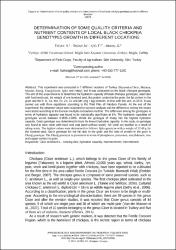DETERMINATION OF SOME QUALITY CRITERIA AND NUTRIENT CONTENTS OF LOCAL BLACK CHICKPEA GENOTYPES GROWTH IN DIFFERENT LOCATIONS
Abstract
This experiment was conducted in 7 different locations of Turkey (Diyarbakir/Dicle, Malatya, Mardin, Elazig, Elazig/Gezin, Igdir and Hatay) and it was conducted on the black chickpea genotypes. The aim of this experiment is to determine the hydration capacity of black chickpea genotypes, seed ratio with hard seed coat, the weight of one hundred seed, the protein content in the grain, the fat content in the grain and the P, K, Ca, Mo, Fe, Zn, Cu and Mn (mg / kg) contents. In line with this aim, in 2015, it was carried out with three repetitions according to the Trial Plan of Random Parcels. At the end of the experiment, the obtained values were subjected to variance analysis and the differences among the means were tested according to the Duncan multiple comparison method. The difference among the genotypes in terms of hydration capacity was found to be statistically significant at 1%. The hydration capacities of genotypes varied between 0.9826-1.0856. While the genotype of Hatay has the highest hydration capacity, Gezin genotype was determined to have the lowest hydration capacity. In the study, no genotype was found to have seeds with hard seed coat (seed without water). All seeds are swollen as a result of taking water. The highest values were determined as follows: Igdir genotype with a weight of 12.40 g for the hundred seed, Gezin genotype for the fat ratio in the grain and the ratio of protein in the grain is Elazig genotype. The Elazig genotype is prominent in terms of phosphorus, potassium, molybdenum, zinc and copper content in grain.


















